NCERT Solutions for Class 6 Maths Chapter 14 Practical Geometry
NCERT Solutions for Class 6 Maths Chapter 14 Practical Geometry are discussed in this article. These NCERT solutions are created by the expert team at careers360 considering the latest CBSE syllabus 2023. Constructions of figures or sketches are mandatory for the design of different types of equipment, instruments, buildings, etc. In CBSE NCERT solutions for Class 6 Maths chapter 14 practical geometry, you will get questions related to constructions of figures using rulers and compass.
This Story also Contains
- NCERT Solutions for Class 6 Maths Chapter 14 Practical Geometry - Important Points
- NCERT Solutions for Class 6 Maths Chapter 14 Practical Geometry
- NCERT Solutions for Class 6 Maths Chapter 14 Practical Geometry (Intext Questions and Exercise)
- NCERT Class 6 Maths Chapter 14 Practical Geometry Exercise 14.1
- NCERT Class 6 Maths Chapter 14 Practical Geometry Exercise 14.2
- NCERT Class 6 Maths Chapter 14 Practical Geometry Exercise 14.3
- NCERT Class 6 Maths Chapter 14 Practical Geometry Exercise 14.4
- NCERT Class 6 Maths Chapter 14 Practical Geometry Exercise 14.5
- NCERT Class 6 Maths Chapter 14 Practical Geometry Topic 14.5.4 Angles of Special Measures
- NCERT Class 6 Maths Chapter 14 Practical Geometry Exercise: 14.6
- Question: 1 Draw $\angle$ POQ of measure 75° and find its line of symmetry.
- Main Topics of NCERT Solutions for Class 6 Maths Chapter 14 Practical Geometry
- NCERT Solutions for Class 6 Mathematics Chapter Wise
- Key Features of NCERT Solutions for Class 6 Maths Chapter 14
- NCERT Solutions for Class 6 Subject Wise
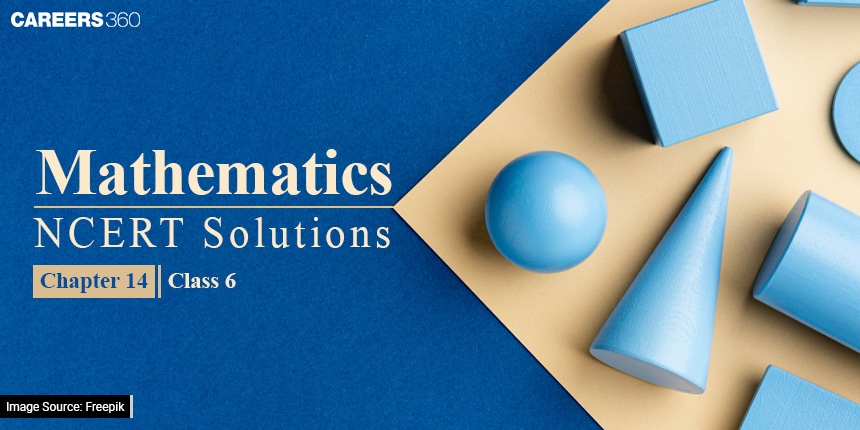
As per the NCERT syllabus for Class 6 Maths, the important topics of this chapter are the construction of the circle of a given radius using a compass, the construction of line segments and angles, etc. In the last exercise of this chapter as mentioned in the NCERT Books for Class 6 Maths, you will get questions related to measuring of angle using a compass and ruler. In some questions in NCERT, you will be drawing lines using the compass. There are many other constructions explained in 6 exercises of NCERT solutions for practical geometry class 6. You will get NCERT Solutions from Class 6 to 12 for Science and Math by clicking on the above link.
NCERT Solutions for Class 6 Maths Chapter 14 Practical Geometry - Important Points
Geometrical shapes: This class 6th maths chapter 14 focuses on the methods used to draw various geometrical shapes. The shapes are constructed using mathematical instruments such as a graduated ruler, compasses, divider, set-squares, and a protractor.
Constructions using ruler and compasses:
(i) Circle: A circle can be drawn when the length of its radius is known. The compasses are used to measure and draw the circle.
(ii) Line segment: With the ruler and compasses, a line segment can be constructed when its length is given.
(iii) Copy of a line segment: The compasses are used to create an exact copy of a given line segment.
For more, Download Ebook - NCERT Class 6 Maths: Chapterwise Important Formulas And Points
(iv) Perpendicular to a line through a point:
- (a) On the line: A perpendicular line can be drawn through a point that lies on the given line.
- (b) Not on the line: A perpendicular line can be drawn through a point that does not lie on the given line.
(v) Perpendicular bisector: The perpendicular bisector of a line segment, which divides it into two equal halves, can be constructed.
(vi) Angle of a given measure: An angle with a specific measure can be constructed using the ruler and compasses.
(vii) Copy of an angle: With the ruler and compasses, an exact copy of a given angle can be drawn.
(viii) Bisector of an angle: The bisector of a given angle, which divides it into two equal angles, can be constructed.
(ix) Special angles: The class 6 maths chapter 14 chapter also covers the construction of angles with special measures such as 90 degrees, 45 degrees, 60 degrees, 30 degrees, 120 degrees, and 135 degrees. These angles are constructed using the ruler and compasses
Free Download NCERT Solutions for Class 6 Maths Chapter 14 Practical Geometry For CBSE Exam
NCERT Solutions for Class 6 Maths Chapter 14 Practical Geometry
NCERT Solutions for Class 6 Maths Chapter 14 Practical Geometry (Intext Questions and Exercise)
NCERT Class 6 Maths Chapter 14 Practical Geometry Exercise 14.1
Question: 1 Draw a circle of radius 3.2 cm.
Answer: To draw a circle of radius 3.2 cm follow the steps given below:
(i) Take compasses for the required radius of 3.2 cm.
(ii) Mark point O where you want the centre of the circle.
(iii) After placing the compass on O, rotate the compasses slowly to make the circle. 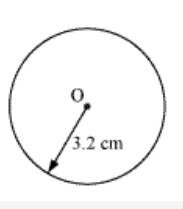
Question: 2 With the same centre O, draw two circles of radii 4 cm and 2.5 cm .
Answer: To draw the required circle follow the steps as follows:
(i) First, Set the compass for radius 4 cm
(ii) Mark point O which will be the centre for the circles.
(iiI) Place the pointer of compasses on O.
(iv) Turn the compasses slowly to draw the circle.
Repeat above 4 steps with the compass set at 2.5 cm 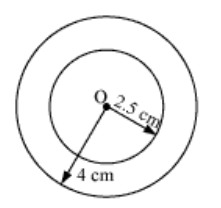
Answer: By joining the ends of the two diameters, we get a rectangle.
Therefore, by measuring, we find that $AB=CD$ and $BC=AD$ , i.e, pairs of opposite sides are equal and also $\angle A = \angle B = \angle C = \angle D = 90^{\circ}$ .
and each angle is fo $90^{\circ}.$
Hence, it is a rectangle: 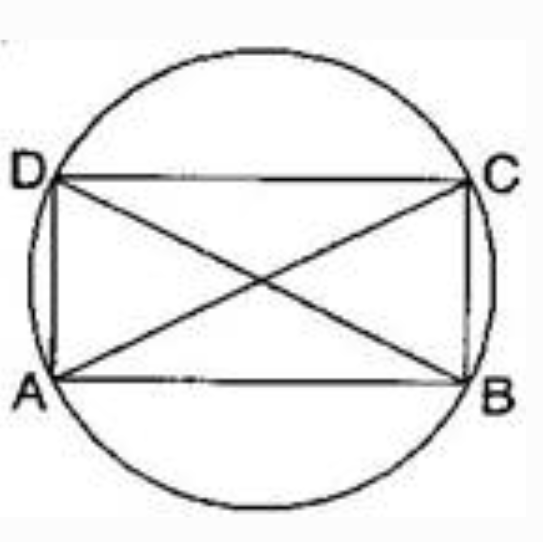
If the diameters are perpendicular to each other, then by joining the ends of two diameters, we get a square.
Then, by measuring the length of the side we find that $AB=BC=CD=DA$ . that is all sides are of the same length also, $\angle A = \angle B = \angle C = \angle D = 90^{\circ}$ , that is each angle is $90^{\circ}.$
Hence, it is a square: 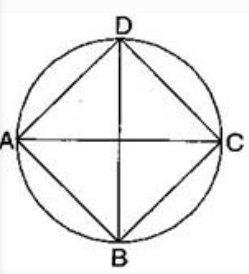
Question: 4 Draw any circle and mark points A, B, and C such that
(a) A is on the circle. (b) B is in the interior of the circle.
(c) C is in the exterior of the circle.
Answer: To draw the circle with the given conditions:
First, mark point 'O' as the centre and place the pointer of the compasses at 'O' then turn the compasses slowly to complete the circle.
Now, mark point A on the circle, mark the point 'B' in the interior of the circle, also point 'C' exterior to the circle. 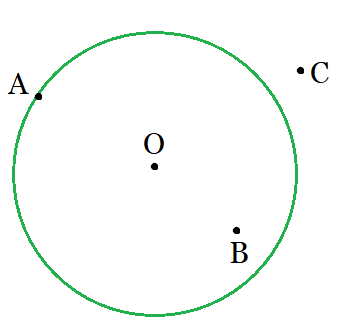
Answer: First, draw two circles of equal radii taking A and B as their centre and they intersect at C and D. Then, join AB and CD.
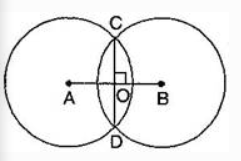 From the figure, AB and CD intersect at right angle with
From the figure, AB and CD intersect at right angle with
NCERT Class 6 Maths Chapter 14 Practical Geometry Exercise 14.2
Question: 1 Draw a line segment of length 7.3 cm using a ruler.
Answer: Let the line segment be 'AB':
Then, follows these steps:
(i) Place the zero mark of the ruler at a point A.
(ii) Mark point B at a distance of 7.3cm from A.
(iii) Now, join AB.
Then, AB is the required line segment of the length of 7.3 cm.
Question: 2 Construct a line segment of length 5.6 cm using ruler and compasses.
Answer:
 (i) Draw a line ′l′. Mark a point A on this line.
(i) Draw a line ′l′. Mark a point A on this line.
(ii) Place the compasses pointer on the zero mark of the ruler. Open it to place the pencil point up to 5.6 cm mark.
(iii) Without changing the opening of the compasses. Place the pointer on A and cut an arc at B on line l.
$\bar{AB}$ is the required line segment of length 5.6 cm.
Answer: The steps of constructions:
 (i) Place the zero mark of the ruler at A.
(i) Place the zero mark of the ruler at A.
(ii) Mark a point B at a distance 7.8 cm from A.
(iii) Again, mark a point C at a distance 4.7 from A.
By measuring $\bar{BC}$ , we find that BC = 3.1 cm

( Hint : Construct $\overline{PX}$ such that length of $\overline{PX}$ = length of $\overline{AB}$ ; then cut off $\overline{XQ}$ such that $\overline{XQ}$ also has the length of $\overline{AB}$ .)
Answer: The steps of constructions are following:

(i) Draw a line ′l′.
(ii) Construct $\bar{PX}$ such that length of $\bar{PX}$ = length of $\bar{AB}$
(iii) Then cut of $\bar{XQ}$ such that $\bar{XQ}$ also has the length of $\bar{AB}$ .
(iv) Thus the length of $\bar{PX}$ and the length of $\bar{XQ}$ added together make twice the length of $\bar{AB}$ .
Verification :
By measurement we find that PQ = 7.8 cm
= 3.9 cm + 3.9 cm = $\bar{AB} + \bar{AB}$ = $2\times\bar{AB} .$
Answer: The steps of construction are as follows:
(i) Draw a line ′l′ and take a point X on it.
(ii) Construct $\bar{XZ}$ such that length $\bar{XZ}$ = length of $\bar{AB}$ = 7.3 cm
(iii) Then cut off $\bar{ZY}$ = length of $\bar{CD}$ = 3.4 cm
(iv) Thus the length of $\bar{XY}$ = length of $\bar{AB}$ – length of $\bar{CD}$

Verification :
By measurement we find that length of $\bar{XY}$ = 3.9 cm
$= 7.3 cm - 3.4cm = \bar{AB} - \bar{CD}$
NCERT Class 6 Maths Chapter 14 Practical Geometry Exercise 14.3
Answer: The steps of constructions are the following: 
(i) Given $\bar{PQ}$ whose length is not known.
(ii) Fix the compasses pointer on P and the pencil end on Q. The opening of the instrument now gives the length of $\bar{PQ}$ .
(iii) Draw any line $'l'$ . Choose a point A on $'l'$ . Without changing the compasses setting, place the pointer on A.
Draw an arc that cuts at $'l'$ a point, say B. Now $\bar{AB}$ is a copy of $\bar{PQ}$ .
Answer: The steps of construction are followings: 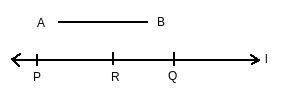
(i) Given $\bar{AB}$ whose length is not known.
(ii) Fix the compasses pointer on A and the pencil end on B. The opening of the instrument now gives the length of $\bar{AB}$ .
(iii) Draw any line $'l'$ . Choose a point P on $'l'$ . Without changing the compasses setting, place the pointer on Q.
(iv) Draw an arc that cuts $'l'$ at a point R.
(v) Now place the pointer on R and without changing the compasses setting, draw another arc that cuts $'l'$ at a point Q.
Thus $\bar{PQ}$ is the required line segment whose length is twice that of AB.
NCERT Class 6 Maths Chapter 14 Practical Geometry Exercise 14.4
Answer: The steps of constructions are the following: 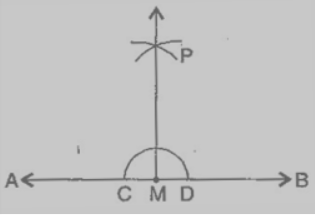
(i) With M as the centre and a convenient radius, draw an arc intersecting the line AB at two points C and B.
(ii) With C and D as centres and a radius greater than MC, draw two arcs, which cut each other at P.
(iii) Join PM. Then PM is perpendicular to AB through point M.
Answer: The steps of constructions are:
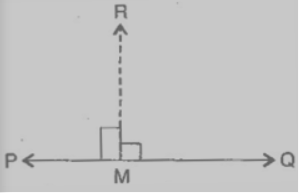
(i) Place a set-square on $PQ$ such that one arm of its right angle aligns along $PQ$ .
(ii) Place a ruler along the edge opposite to the right angle of the set-square.
(iii) Hold the ruler fixed. Slide the set square along the ruler till the point R touches the other arm of the set square.
(iv) Join RM along the edge through R meeting $PQ$ at M. Then RM ⊥ PQ.
Question: 3 Draw a line l and a point X on it. Through X, draw a line segment $\overline{XY}$ perpendicular to l . Now draw a perpendicular to $\overline{XY}$ at Y. (use ruler and compasses)
Answer: The steps of construction are as follows:
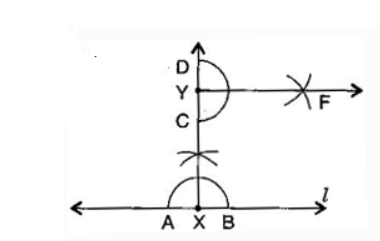
(i) Draw a line $'l'$ and take point X on it.
(ii) With X as the centre and a convenient radius, draw an arc intersecting the line $'l'$ at two points A and B.
(iii) With A and B as centres and a radius greater than XA, draw two arcs, which cut each other at C.
(iv) Join AC and produce it to Y. Then XY is perpendicular to $'l'$ .
(v) With Y as the centre and a convenient radius, draw an arc intersecting XY at two points C and D.
(vi) With C and D as centres and radius greater than YD, draw two arcs which cut each other at F.
(vii) Join YF, then YF is perpendicular to XY at Y.
NCERT Class 6 Maths Chapter 14 Practical Geometry Exercise 14.5
Question: 1 Draw $\overline{AB}$ of length 7.3 cm and find its axis of symmetry.
Answer: The axis of symmetry of the line segment $\bar{AB }$ will be the perpendicular bisector of $\bar{AB }$ . So, draw the perpendicular bisector of AB.
The steps of constructions are as follows: 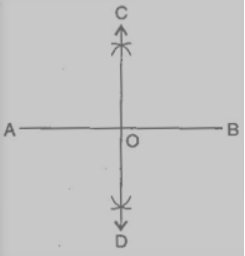
(i) Draw a line segment $\bar{AB }$ = 7.3 cm
(ii) Taking A and B as centres and radius more than half of AB, draw two arcs which intersect each other at C and D.
(iii) Join CD. Then CD is the axis of symmetry of the line segment AB.
Question: 2 Draw a line segment of length 9.5 cm and construct its perpendicular bisector.
Answer: The steps of constructions are: 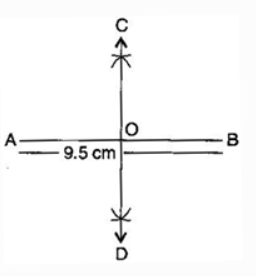
(i) Draw a line segment $\bar{AB}$ = 9.5 cm
(ii) Taking A and B as centres and radius more than half of AB, draw two arcs which intersect each other at C and D.
(iii) Join CD. Then CD is the perpendicular bisector of $\bar{AB}$ .
Answer: Follow the steps to draw the perpendicular bisector of a line XY.
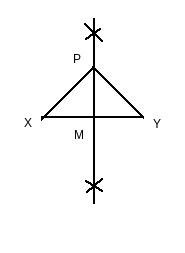
a) PX= PY
b)MX=MY
Answer: The steps of constructions are:
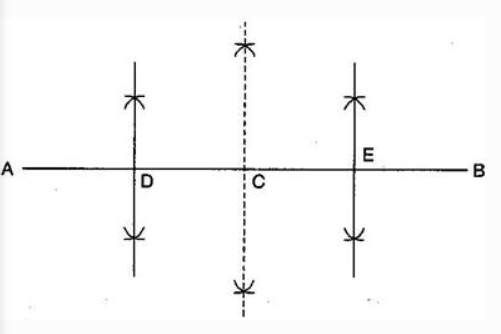
(i) Draw a line segment AB = 12.8 cm
(ii) Draw the perpendicular bisector of $\bar{AB}$ which cuts it at C. Thus, C is the mid-point of $\bar{AB}$ .
(iii) Draw the perpendicular bisector of $\bar{AC}$ which cuts it at D. Thus D is the mid-point of .
(iv) Again, draw the perpendicular bisector of $\bar{CB}$ which cuts it at E. Thus, E is the mid-point of $\bar{CB}$ .
(v) Now, point C, D, and E divide the line segment $\bar{AB}$ in the four equal parts.
(vi) By actual measurement, we find that
$\bar{AD} = \bar{DC} = \bar{CE} = \bar{EB} = 3.2cm$
Question: 5 With PQ of length 6.1 cm as diameter, draw a circle.
Answer: The steps of constructions are: 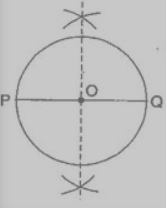
(i) Draw a line segment $\bar{PQ}$ = 6.1 cm.
(ii) Draw the perpendicular bisector of PQ which cuts, it at O. Thus O is the mid-point of $\bar{PQ}$ .
Taking O as the centre and OP or OQ as radius draw a circle where the diameter is the line segment $\bar{PQ}$ .
Answer: The steps of constructions are: 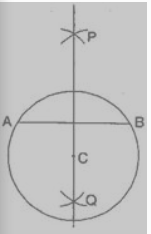
(i) Draw a circle with centre C and radius 3.4 cm.
(ii) Draw any chord $\bar{AB}$ .
(iii) Taking A and B as centres and radius more than half of $\bar{AB}$ , draw two arcs which cut each other at P and Q.
(iv) Join PQ. Then PQ is the perpendicular bisector of $\bar{AB}$ .
This perpendicular bisector of $\bar{AB}$ passes through the centre C of the circle.
Question: 7 Repeat Question 6, if AB happens to be a diameter.
Answer: The steps of constructions are:
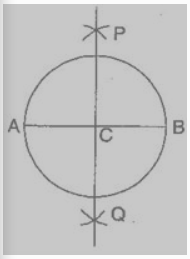
(i) Draw a circle with centre C and radius 3.4 cm.
(ii) Draw its diameter $\bar{AB}$
(iii) Taking A and B as centres and radius more than half of it, draw two arcs which intersect each other at P and Q.
(iv) Join PQ. Then PQ is the perpendicular bisector of $\bar{AB}$
We observe that this perpendicular bisector of $\bar{AB}$ passes through the centre C of the circle.
Answer: The steps of constructions are: 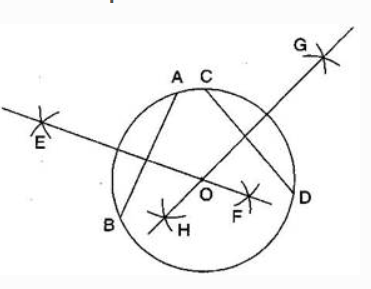
(i) Draw the circle with O and radius 4 cm.
(ii) Draw any two chords $\bar{AB}$ and $\bar{CD }$ in this circle.
(iii) Taking A and B as centres and radius more than half AB, draw two arcs which intersect each other at E and F.
(iv) Join EF. Thus EF is the perpendicular bisector of chord $\bar{CD }$ .
(v) Similarly draw GH the perpendicular bisector of chord $\bar{CD }$ .
These two perpendicular bisectors meet at O, the centre of the circle.
Answer: The steps of constructions are:
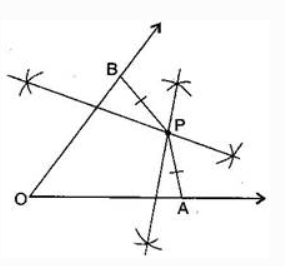
(i) Draw any angle with vertex O.
(ii) Take a point A on one of its arms and B on another such that
(iii) Draw perpendicular bisector of $\bar{OA}$ and $\bar{OB}$ .
(iv) Let them meet at P. Join PA and PB.
With the help of divider, we obtained that $\bar{PA} = \bar{PB}.$
NCERT Class 6 Maths Chapter 14 Practical Geometry Topic 14.5.4 Angles of Special Measures
Question: How will you construct a 15° angle?
Answer: First, we make $30^{\circ},$ and then its bisector.
The steps of constructions are:
1. Draw a ray OA.
2. Taking O as the center and any radius of your own choice, draw an arc cutting OA at B.
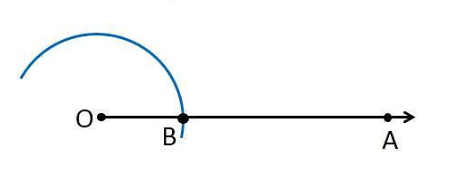
3. Now, taking B as center and with the same radius as before, draw an arc intersecting the previously drawn arc at point C.
4. Draw the ray OD passing through the C.
Thus, $\angle AOD = 60^{\circ}$
Now, we draw bisector of $\angle AOD$
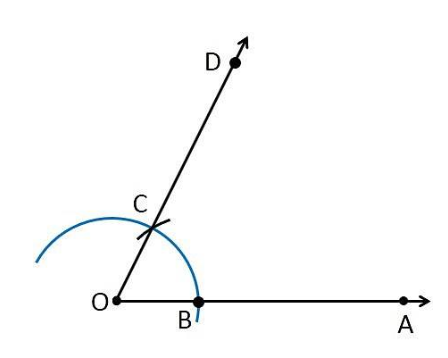
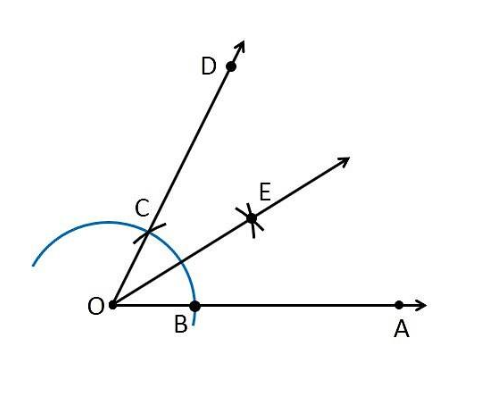
5. Taking C and D as the center, with radius more than $\frac{1}{2}CD$ , draw arcs intersecting at E.
6. Join OE.
Thus, $\angle AOE = 30^{\circ}$
Now, we draw the bisector of $\angle AOD$
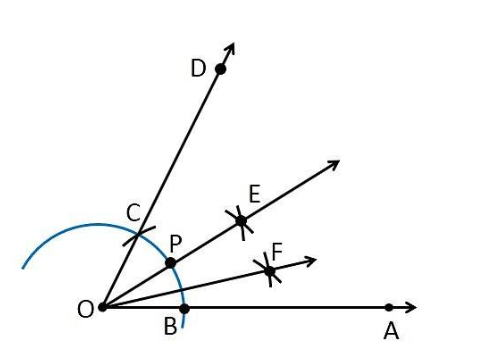
7. Mark point P where the ray OE intersects the arc.
8. Taking P and B as center, with having the radius more than $\frac{1}{2}PB$ , draw arcs intersecting at F.
9. Join OF
Thus, $\angle AOF = 15^{\circ}.$
Question: How will you construct a 150° angle?
Answer: Take a line segment, say, AB.
Choose a point C on it.
With center C, and radius BC, draw an arc.
With center B and radius BC, cut the previous arc at say DD.
$(\angle DCB=60^{\circ}\ because\ we\ just\ made\ CD=BC=BD )$
With center D, and radius BC draw an arc.
With center B and radius BC, cut this arc at, say, EE.
Then EC is the bisector of ∠BCD, and
Hence, $\angle BCE=30^{\circ}$
Then, $\angle ACE=180^{\circ} - \angle BCE=150^{\circ}$
Question: How will you construct a 45° angle?
Answer:
1. Draw a ray OA.
2. Taking O as center and any radius, draw an arc cutting OA at B.
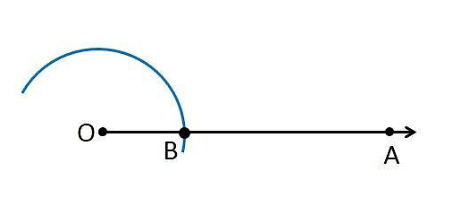
3. Now, taking B as center and with the same radius as before, draw an arc intersecting the previously drawn arc at point C.
4. With C as the center and the same radius, draw an arc cutting the arc at D.
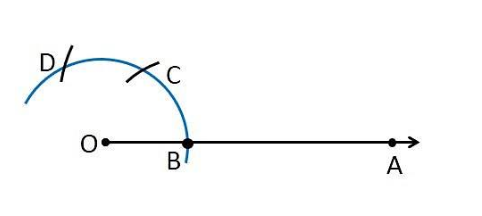 \
\
5. With C and D as centers and radius more than  , draw two arcs intersecting at P.
, draw two arcs intersecting at P.
6. Join OP.
Thus, 
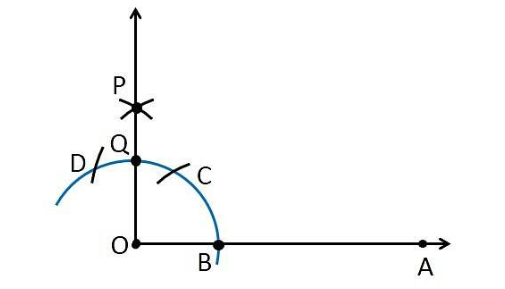
Now, we draw the bisector of 
7. Let OP intersects the original arc at point Q.
8. Now, taking B and Q as centers, and radius greater than  draw two arcs intersecting at R.
draw two arcs intersecting at R.
9. Join OR.
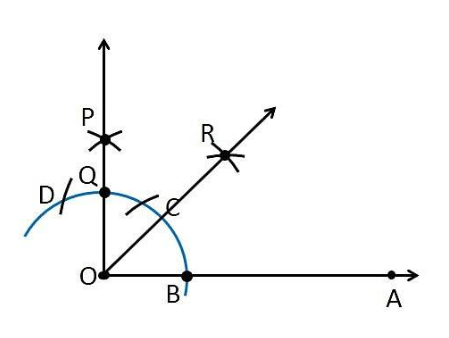
Thus, 
NCERT Class 6 Maths Chapter 14 Practical Geometry Exercise: 14.6
Question: 1 Draw $\angle$ POQ of measure 75° and find its line of symmetry.
Answer:
1. Draw a ray OA.

2. Place the centre of the protractor on point O, and coincide line OA and Protractor line
3. Mark point B on 75 degrees.
4. Join OB
Therefore 
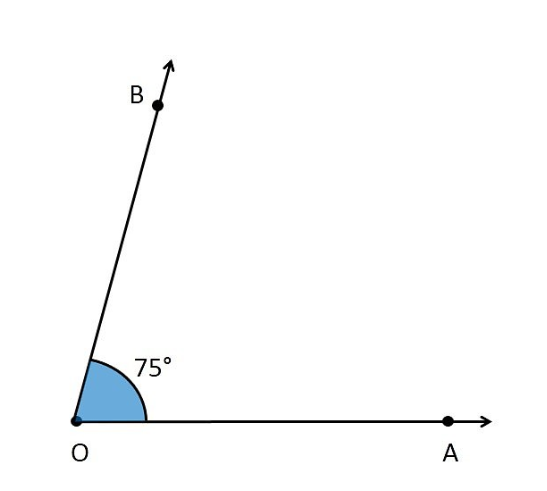
Now, we need to find its line of symmetry
that is, we need to find its bisector.
We follow these steps
1. Mark points C and D where the arc intersects OA and OB
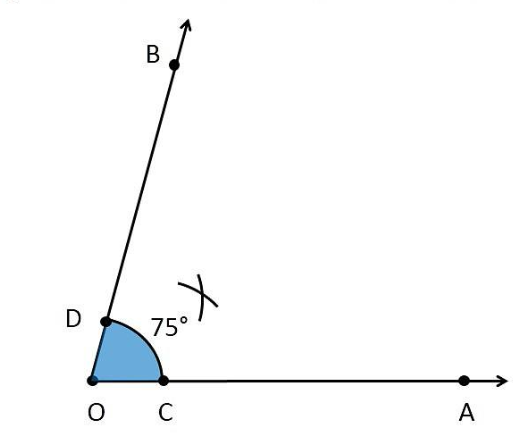
2. Now, taking C and D as centres and with the radius more than  , draw arcs to intersects each other.
, draw arcs to intersects each other.
3. Let them intersects at point E.
4. Join O and E.
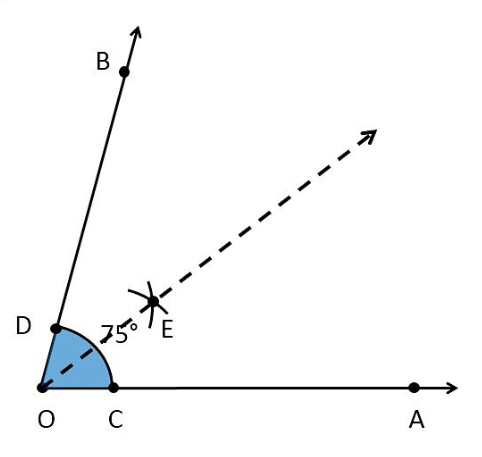
Therefore OE is the line of symmetry of 
Question: 2 Draw an angle of measure 147° and construct its bisector.
Answer: The steps of constructions are:
1. Draw a line OA.
2. Using protractor and centre 'O draw an angle AOB =147°.
3. Now taking 'O' as the centre and any radius draws an arc that intersects 'OA' and 'OB' at p and q.
4. Now take p and q as centres and radius more than half of PQ, draw arcs.
5. Both the arcs intersect at 'R'
6. Join 'OR' and produce it.
7. 'OR' is the required bisector of angle AOB. 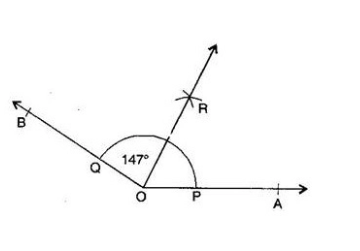
Question: 3 Draw a right angle and construct its bisector.
Answer: The steps of construction:
(a) Draw a line PQ and take a point O on it.
(b) Taking O as the centre and convenient radius, draw an arc that intersects PQ at A and B.
(c) Taking A and B as centres and radius more than half of AB, draw two arcs which intersect each other at C.
(d) Join OC. Thus, ∠COQ is the required right angle.
(e) Taking B and E as centre and radius more than half of BE, draw two arcs that intersect each other at point D.
(f) Join OD. Thus, the OD bar is the required bisector of ∠COQ.
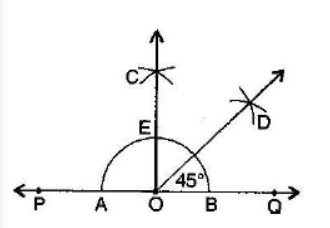
Question: 4 Draw an angle of measure 153° and divide it into four equal parts.
Answer: The steps of constructions are:
(a) Draw a ray OA.
(b) At O, with the help of a protractor, construct ∠AOB = 153 degrees.
(c) Draw OC as the bisector of ∠AOB.
(d) Again, draw OD as bisector of ∠AOC.
(e) Again, draw OE as bisector of,∠BOC.
(f) Thus, OC, OD, and OE divide ∠AOB into four equal parts.
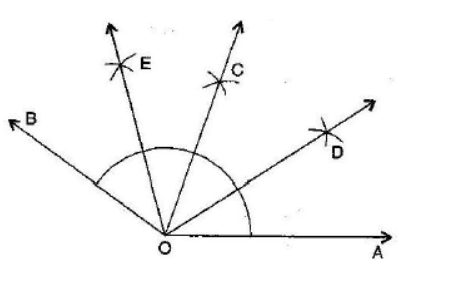
Question: 5(a) Construct with ruler and compasses, angles of following measures:
Answer: The steps of constructions are:
1. Draw a ray OA
2. Taking O as the centre and convenient radius, mark an arc, which intersects OA at P.
3. Taking P as the centre and the same radius, cut the previous arc at Q. Join OQ. Thus,∠BOA is the required angle of 60°
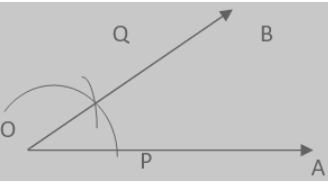
Question:5(b) Construct with ruler and compasses, angles of following measures:
30 o
Answer: The steps of constructions are:
1. Draw a ray OA.
2. Taking O as the centre and convenient radius, mark an arc, which intersects OA at P.
3. Taking P as the centre and the same radius, cut the previous arc at Q. Join OQ. Thus, ∠BOA is the required angle of 60°.
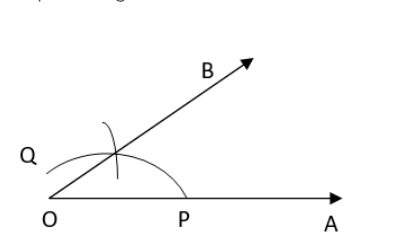
4. Put the pointer on P and mark an arc.
5. Put the pointer on Q and with the same radius, cut the previous arc at C. Thus, ∠COA is required angle of 30° 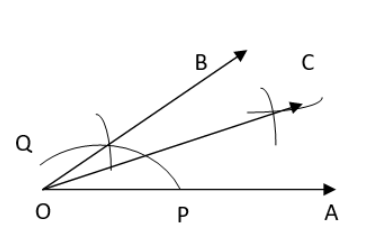
Question: 5(c) Construct with ruler and compasses, angles of following measures:
90 o
Answer: The steps of constructions are:
1. Draw a ray OA
2. Taking O as the centre and convenient radius, mark an arc, which intersects OA at X.
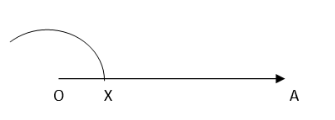
3. Taking X as the centre and the same radius, cut the previous arc at Y. Taking Y as the centre and the same radius, draw another arc intersecting the same arc at Z. 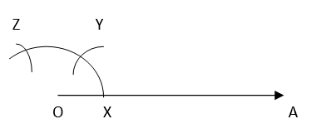 4. Taking Y and Z as centres and the same radius, draw two arcs intersecting each other at S.
4. Taking Y and Z as centres and the same radius, draw two arcs intersecting each other at S.
5. Join the OS. Thus, ∠SOA is a required angle of 90°
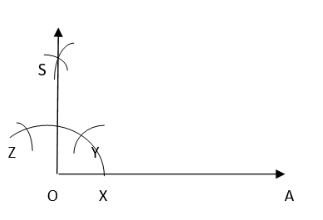
Question: 5(d) Construct with ruler and compasses, angles of following measures:
120 o
Answer: The steps of constructions are:
1. Draw a ray OA
2. Taking O as the centre and convenient radius, mark an arc, which intersects OA at P.
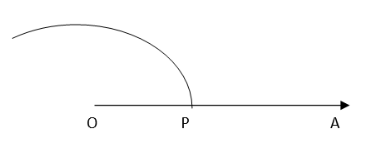
3. Taking P as the centre and same radius, cut the previous arc at Q. Taking Q as the centre and the same radius cut the arc at S. Join OS. Thus, ∠AOS is the required angle of 120°. 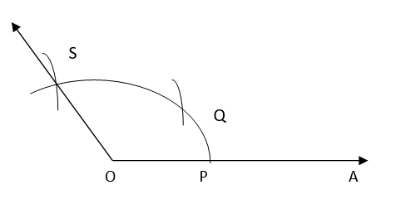
Question:5(e) Construct with ruler and compasses, angles of following measures:
45 o
Answer: The steps of constructions are:
1. Draw a ray OA
2. Taking O as the centre and convenient radius, mark an arc, which intersects OA at X. 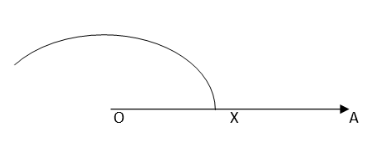
3. Taking X as the centre and the same radius, cut the previous arc at Y. Taking Y as the centre and the same radius, draw another arc intersecting the same arc at Z.
4. Taking Y and Z as centres and the same radius, draw two arcs intersecting each other at S. Join OS. Thus, ∠SOA is a required angle of 90°. 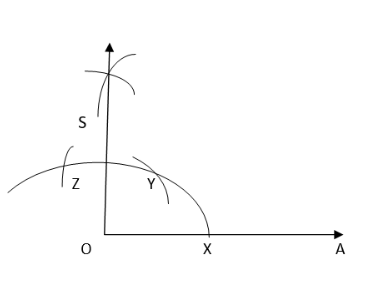
5. Draw the bisector of SOA. Hence, ∠MOA = 45°
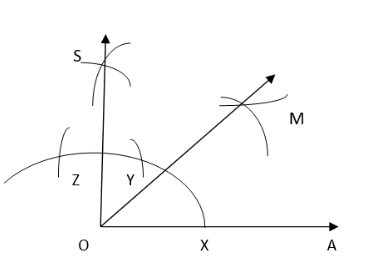
Question: 5(f) Construct with ruler and compasses, angles of following measures:
135 o
Answer: The steps of constructions are:
1. Draw a line PQ and take a point O on it.
2. Taking O as the centre and convenient radius, mark an arc, which intersects PQ at A and B.

3. Taking A and B as centres and radius more than half of AB, draw two arcs intersecting each other at R. Join OR. Thus, ∠QOR = ∠POR = 90°. 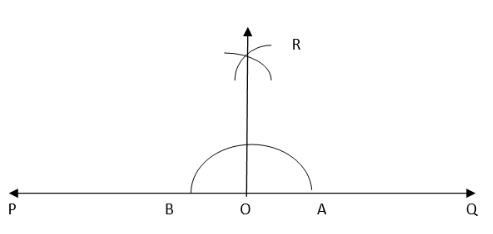
4. Draw OD the bisector of ∠POR. Thus, ∠QOD is required angle of 135°
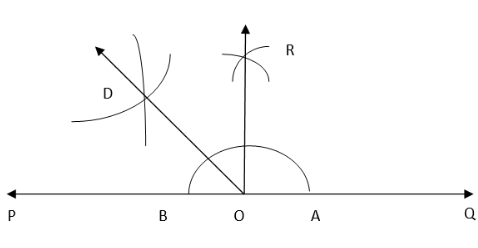
Question: 6 Draw an angle of measure 45° and bisect it.
Answer: The steps of constructions are:
1. Draw a ray OA
2. Taking O as the centre and convenient radius, mark an arc, which intersects OA at X.
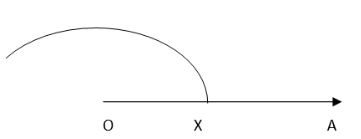
3. Taking X as a centre and the same radius, cut the previous arc at Y. Taking Y as the centre and the same radius, draw another arc intersecting the same arc at Z.
4. Taking Y and Z as centres and the same radius, draw two arcs intersecting each other at S. Join OS. Thus, ∠SOA is a required angle of 90°. 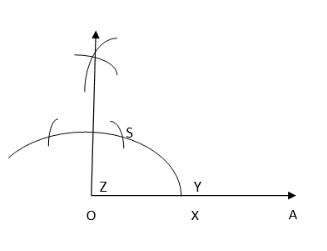
5. Draw the bisector of ∠SOA. Hence, ∠MOA = 45°
6. Draw the bisector of ∠MOA. Hence, ∠NOA= 22.5 0
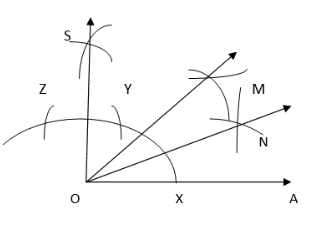
Question: 7 Draw an angle of measure 135° and bisect it.
Answer: The steps of constructions are:
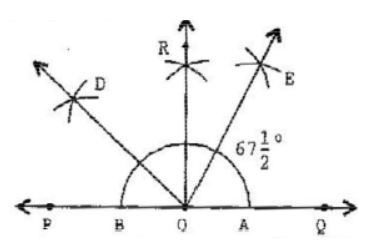
(a) Draw a line PQ and take a point O on it.
(b) Taking O as the centre and convenient radius, mark an arc, which intersects PQ at A and B.
(c) Taking A and B as centres and radius more than half of AB, draw two arcs intersecting each other at R.
(d) Join OR. Thus, ∠QOR = ∠POQ = 90 .
(e) Draw OD the bisector of ∠POR. Thus, ∠QOD is the required angle of 135.
(f) Now, draw OE as the bisector of ∠QOD=1/2 of 135=67.5
Question: 8 Draw an angle of 70 o . Make a copy of it using only a straight edge and compasses.
Answer: The steps of constructions are: 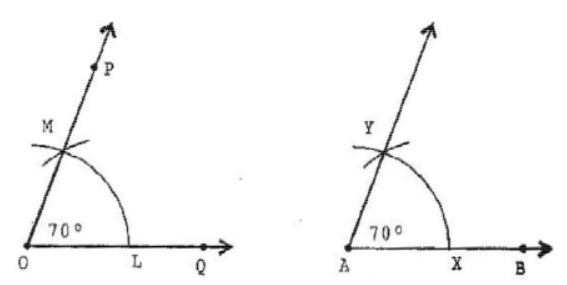
(a) Draw an angle 70 degrees with a protractor, i.e., ∠POQ = 70 degrees
(b) Draw a ray AB.
(c) Place the compasses at O and draw an arc to cut the rays of ∠POQ at L and M.
(d) Use the same compasses, setting to draw an arc with A as the centre, cutting AB at X.
(e) Set your compasses setting to the length LM with the same radius.
(f) Place the compasses pointer at X and draw the arc to cut the arc drawn earlier at Y.
(g) Join AY. Thus, ∠YAX = 70 degree
Question: 9 Draw an angle of 40 o . Copy its supplementary angle.
Answer: 
The steps of constructions are:
(a) Draw an angle of 40 degrees with the help of a protractor, naming ∠ AOB.
(b) Draw a line PQ.
(c) Take any point M on PQ.
(d) Place the compasses at O and draw an arc to cut the rays of ∠AOB at L and N.
(e) Use the same compasses setting to draw an arc O as the centre, cutting MQ at X.
(f) Set your compasses to length LN with the same radius.
(g) Place the compasses at X and draw the arc to cut the arc drawn earlier Y.
(h) Join MY.
(i) Thus, < QMY = 40 degree and < PMY is supplementary of it.
Main Topics of NCERT Solutions for Class 6 Maths Chapter 14 Practical Geometry
- The Circle
- Construction of a circle when its radius is known
- A-Line Segment
- Construction of a line segment of a given length
- Constructing a copy of a given line segment
- Perpendiculars
- Perpendicular to a line through a point on it
- Perpendicular to a line through a point not on it
- The perpendicular bisector of a line segment
- Angles
- Constructing an angle of a given measure
- Constructing a copy of an angle of an unknown measure
- Bisector of an angle
- Angles of special measures
Also Check
NCERT Books and NCERT Syllabus
NCERT Solutions for Class 6 Mathematics Chapter Wise
| Chapters No. | Chapters Name |
| Chapter - 1 | Knowing Our Numbers |
| Chapter - 2 | Whole Numbers |
| Chapter - 3 | Playing with Numbers |
| Chapter - 4 | Basic Geometrical Ideas |
| Chapter - 5 | Understanding Elementary Shapes |
| Chapter - 6 | Integers |
| Chapter - 7 | Fractions |
| Chapter - 8 | Decimals |
| Chapter - 9 | Data Handling |
| Chapter -10 | Mensuration |
| Chapter -11 | Algebra |
| Chapter -12 | Ratio and Proportion |
| Chapter -13 | Symmetry |
| Chapter -14 | Practical Geometry |
Key Features of NCERT Solutions for Class 6 Maths Chapter 14
Expertly Crafted Solutions: The NCERT Solutions for Chapter 14 are meticulously developed to offer clear and precise explanations for all the problems and concepts discussed in the chapter.
Conceptual Clarity: The solutions aim to improve students' conceptual understanding by simplifying complex topics and presenting them in a more comprehensible manner.
Comprehensive Coverage: The solutions cover all the essential topics and subtopics of Chapter 14, ensuring that students gain a thorough understanding of the entire chapter.
NCERT Solutions for Class 6 Subject Wise
Benefits of NCERT Solutions for Class 6 Maths Chapter 14 Practical Geometry-
- You will get NCERT Solutions for Class 6 very easily.
- You will get some different ways to construct geometrical in this solution article.
- There are some figures and images given in these solutions. It will help you in drawing geometrical figures easily.
- In CBSE NCERT solutions for Class 6 Maths chapter 14 Practical Geometry, you will find that questions are explained with step-by-step to construct lines and geometrical figures with the help of compass and rulers. So you can understand easily
- It is going to help you with your homework as well.
Happy learning!!!
Popular Questions
Courses After 12th
Applications for Admissions are open.
As per latest syllabus. Physics formulas, equations, & laws of class 11 & 12th chapters
JEE Main Important Chemistry formulas
Get nowAs per latest syllabus. Chemistry formulas, equations, & laws of class 11 & 12th chapters
JEE Main high scoring chapters and topics
Get nowAs per latest 2024 syllabus. Study 40% syllabus and score upto 100% marks in JEE
JEE Main Important Mathematics Formulas
Get nowAs per latest syllabus. Maths formulas, equations, & theorems of class 11 & 12th chapters
